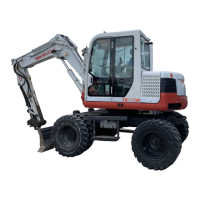24
SAFETY
Transporting Precautions
Load and unload the machine
safely
The machine may roll or tip over or fall while
loading or unloading it. Take the following
precautions:
Select a firm, level surface and keep
sufficient distance from road shoulders.
Use loading ramps of adequate strength
and size. Maintain the slope of loading
ramps within 15 degrees. I
f the rumps
are bowed down too low, support them
with poles or blocks.
Secure the ramps to the trailer deck.
Keep the trailer deck and loading ramps
clean of oil, clay, ice, snow, and other
materials which can become slippery.
Clean the machine tires.
Block the trailer so it can not move.
Use a signal person when loading and
unloading the machine, and travel slowly
in site travel gear.
Never change course on the ramp.
Do not slew (swing) on ramps. The machine
may tip over.
When slewing (swinging) on the trailer
deck, do so slowly as the footing can be
unstable.
Engage the slew (swing) lock after
loading.
Block the machine tires and secure the
machine to the trailer deck with load
binders.
Hoist the machine safely
Know and use correct crane signals.
Check the hoisting equipment for damaged
or missing parts on a daily basis and
replace as necessary.
When hoisting, use a wire rope capable of
lifting the machine mass.
Hoist the machine in such a manner
described in the procedure below. Do not
do it in any other manner, as it may result
in the machine losing its balance.
Refer to “Hoisting the machine” for further
instructions.
Do not hoist the machine with an operator
on it.
When hoisting, hoist slowly so that the
machine does not tip.
Keep everyone out of the area when
hoisting. Do not move the machine over
the heads of the persons.
Transport the machine safely
Know and follow the safety rules, vehicle
code and traffic laws when transporting
the machine.
Consider the length, width, height and
weight of the trailer with the machine
loaded on it when determining the best
route.
W2F001E
Trailer
Ramp
Stopper
15° or less

